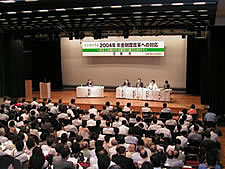460 Attend Pension System Reform Symposium
(8 Aug 2003)
 |
| Photo: The conference was packed with more participants than expected. |
He frowned upon the introduction of “fixed pension premiums” supported by the Ministry since it would lower benefit levels: “not only will they be unable to fulfill the main role of security of post-retirement life, but they may lead to further deterioration of younger people’s distrust of the pension system.” He wanted to the audience to understand the main points of reform that RENGO is seeking, pointing out that “the pension system structure should maintain the bi-level model of the basic pension (Level 1) and a remuneration based portion (Level 2)” further, “expanding employee pension coverage to include part-time workers is also a crucial topic.”
Afterwards, a panel discussion was held with the following panelists: Democratic Party of Japan, House of Councilors member Takashi Yamamoto, Health, Labour & Welfare Ministry, Pension Bureau Director General Tamiki Yoshitake, Ministry of Public Management, Home Affairs, Posts and Telecommunications, Local Finance Council member Yoko Kimura, RENGO Welfare Policy Division Director Shigeru Kojima, and Toyo University Dept. of Social Economic Systems Associate Professor Kohei Komamura (Coordinator).
The panel exchanged opinions on how the structure of the system and methods of finance should function, whether by taxes, proportional income?social insurance, etc. They also discussed whether benefit levels would be maintained at current levels and what we thought about fixed pension premiums, which the HLW Ministry is proposing. Other opinions raised on the debate floor included: someone who urged the Pension Subcommittee to consider the restaurant industry and another seeking concrete plans to resolve women’s and pension issues.
Finally, Associate Professor Komamura raised the four following important future issues before closing the symposium. [1] Hold basic discussions in order to clarify what should be done with the pension system’s structure. [2] The Ministry of Health, Labour and Welfare will continue to offer easy-to-understand lectures on the reform contents. [3] Do not discuss pensions, medical care, nursing care, or welfare benefits for the needy piecemeal but rather discuss social security as a whole. [4] An aging society does not guarantee disruption of the pension system. We must consider pension system reform with cooperation from all generations.